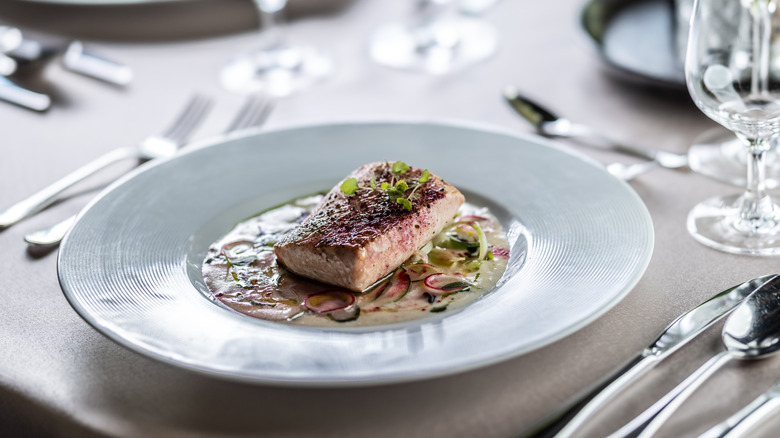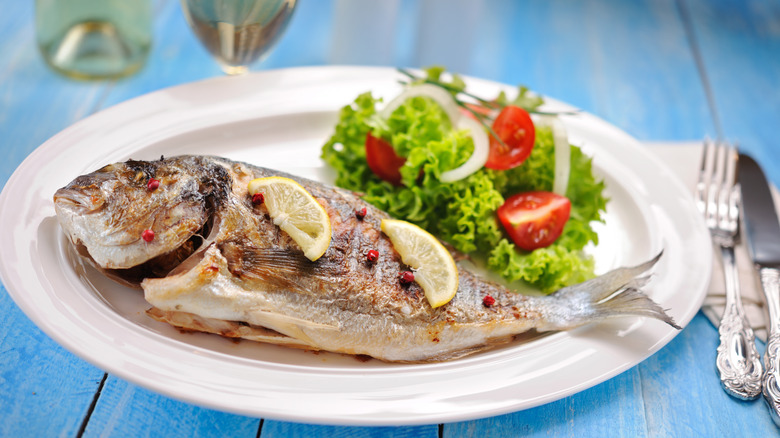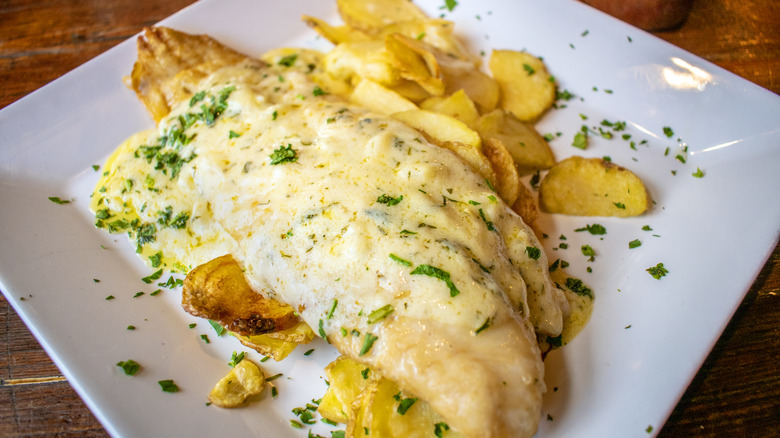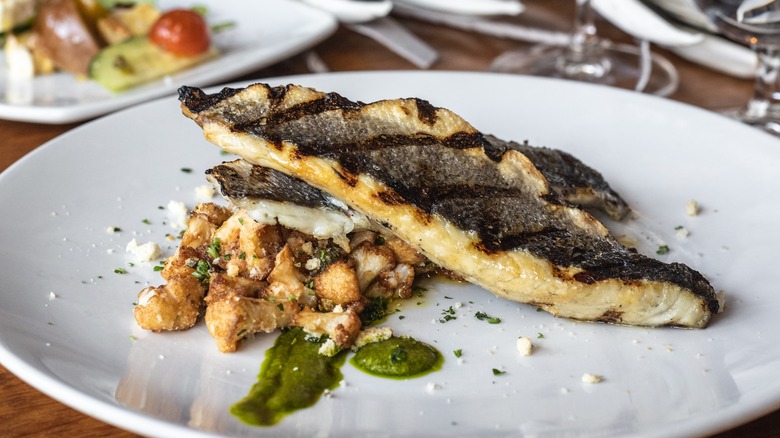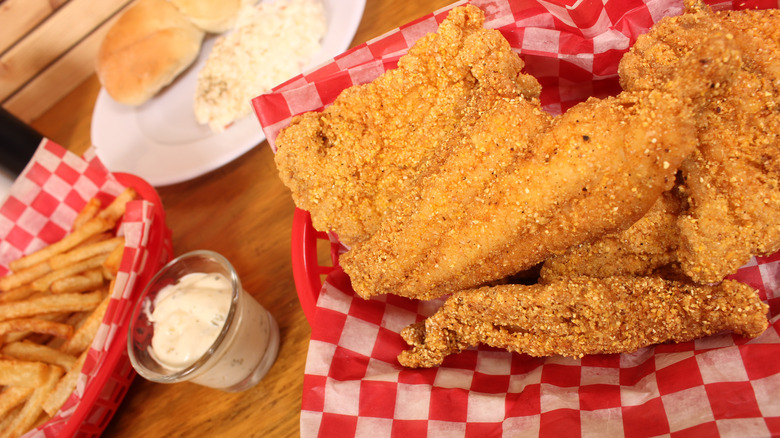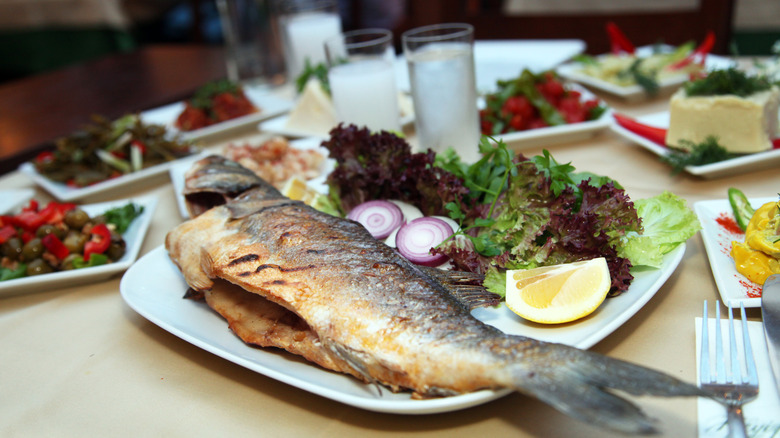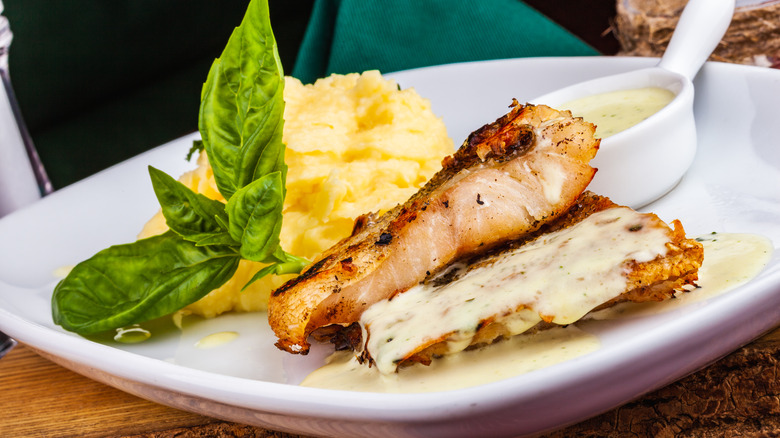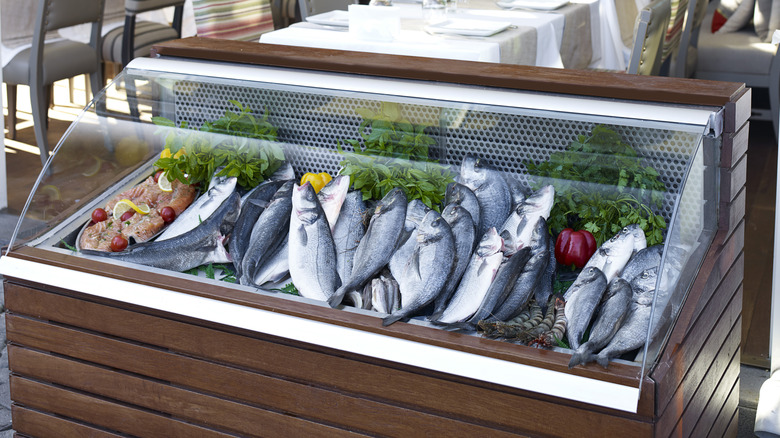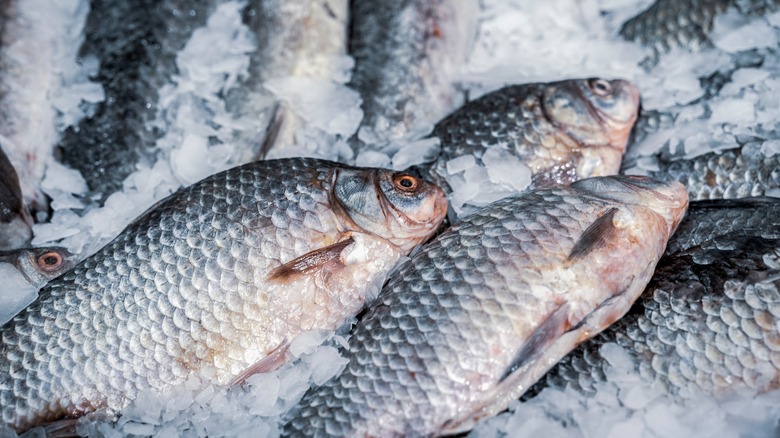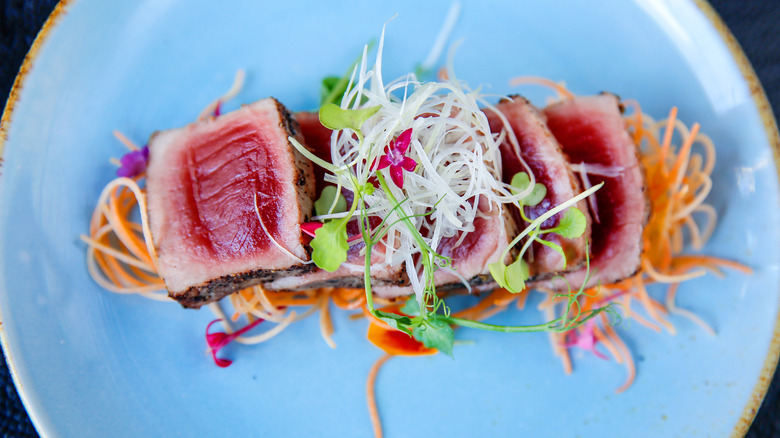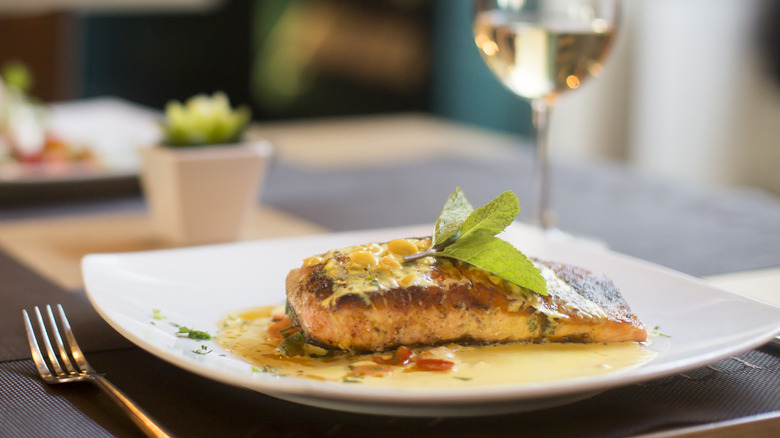Seafood Experts Reveal 11 Words And Phrases You Shouldn't Use When Ordering Fish
We're often willing to shell out a little more on fish when we go out to eat. It's pricey enough in the supermarkets, and maybe we don't have the right kitchen equipment — or confidence — to tackle cooking a delicate fish. Regardless, ordering fish at restaurants is an experience you can't take too lightly if you want to get the most out of your meal (and money). While there are plenty of fish in the sea, there are possibly even more considerations we need to take to avoid cheap fish that aren't worth your time, but also help the restaurant help you truly enjoy your food.
Chef de Cuisine Joel Hammond from West Hollywood's sushi restaurant Uchi admits that choosing a good restaurant is the most important first step. "Most of the work should be done ahead of time in terms of ordering fish," he says. "Know where it is coming from, and make sure it is a reputable source."
For those of you on the coasts, you can probably have a little more faith in that fresh fish special, but for land-locked folk, we'll have to be even more discerning. Along with Hammond, we've consulted other chefs who consider themselves experts in everything fish, including chef Andy Bruch from Point Easy; chef Alfredo Nogueira from Cane and Table; and chef Hunter Evans from The Mayflower Cafe. They've guided us through some of the most common misconceptions and phrases we need to avoid before ordering fish at restaurants.
I don't order fish on Mondays
Before becoming a household name in all of our kitchens, the late Anthony Bourdain once famously warned readers in a New Yorker article to avoid ordering fish on Mondays. While Bourdain grew to be so much more than some of his early opinions, many fans faithfully held onto this seemingly solid mantra. If you are one of these believers, however, just know that it's okay to let go.
Chef Alfredo Nogueira from Cane & Table — a Cuban and Louisiana Creole-inspired restaurant in New Orleans' French Quarter — reveals that things are not as black and white as simply avoiding fish on Mondays. "If fish is handled properly and stored with care it can last longer than most people think," he says. "If the restaurant has a good reputation and you see people there ordering the fish, go for it."
In that regard, do a little research before heading to the restaurant and take some visual cues while you're there. Does it seem reputable, organized, and clean? Even Bourdain later walked back his statement, largely because of broader shifts in dining culture. Now, restaurant-goers are more concerned with what's healthiest and most sustainable, incentivizing restaurants to source higher quality foods and implement safer practices.
Do you have any cheesy fish dishes?
Like most hard and fast culinary rules, there are definitely some notable exceptions to keeping fish and cheese apart. Think of lox and cream cheese or even — we won't judge — McDonald's Filet-O-Fish. Chef and owner of Point Easy — an upscale Denver restaurant specializing in local and seasonal dishes — Andy Bruch remarks that there are endless possibilities for preparing and pairing fish. "The flavor combinations are really incredible and I think your condiment choices are limited by what you like and where your imagination takes you," he says. "But yes, fish and cheese just generally don't make great bedfellows."
For starters, oily fish like sardines and anchovies don't really benefit from something equally rich and greasy like cheese. Additionally, flaky, white fishes are too subtle to be buried under a blanket of goo, and won't make for a satisfying textural duo. It's why we generally reach for lighter, brighter flavors, like the age-old fish and lemon combo, or a dab of tartar sauce.
"It's also a bit of a terroir thing," Bruch adds. "Most cultures with fish-rich diets also don't produce a lot of cheese (think Japan)." Similarly, fish and cheese didn't travel very well before refrigeration, so Italian regions known for their cheeses didn't take much inspiration from coastal regions known for their fresh fish. Despite modern transportation, we still tend to defer to the Europeans for our culinary faux pas, meaning you should maybe pass on the cheese dip with your halibut.
If it's farm-raised, I don't want it
When it comes to farm-raised versus wild-caught fish, most people's knee-jerk reaction tells us to go for the latter. At best, farm-raised can sound a little fishy, and probably brings to mind something like factory-raised chickens crammed into cages. However, Joel Hammond admits one of his biggest pet peeves is people swearing they'll only eat wild-caught fish. "People tend to think wild-caught is fresher and better than farmed fish, which is usually not the case," he says. "There are so many wonderful farmed/ranched fish programs these days and it is usually far more sustainable and better for the environment."
Ethically farm-raising fish can drastically reduce the pressures on wild populations, allowing them to build their numbers and return to a more natural lifestyle. Nutritionally, wild-caught fish tend to be leaner but higher in mercury, while fish from eco-friendly farms are carefully controlled for flavor and nutrition. Plus, farm-raised fish provides an opportunity to eat fresher than what is exclusively native to your region or currently seasonal. The flaky, white branzino, for example, would be considerably more difficult to affordably eat if it weren't for farm-raised options.
On that note, it's usually more sustainable to eat local, farm-raised fish, as opposed to wild-caught from halfway across the world. If possible, ask the restaurant how its fish is caught, and don't automatically discount the farm-raised option.
I'll pass on the catfish
Catfish just can't seem to catch a break. Globally, they are one of the most common and diverse freshwater fishes, yet we can't seem to get over their funky flavor and the fact that they are bottom feeders. For the more health-conscious among us, it probably doesn't help that we often see the fish breaded and fried, served up with a side of fries and coleslaw. Chef Alfredo Nogueira recognizes the negative stigma, but admits that he loves catfish. "When I was younger, I used to think it wasn't good until I had catfish from my best friend's dad's camp," he remembers. "I loved it so much I later put catfish nuggets fried in the style he did and named it 'Catfish Deville.'"
Most of the catfish we eat in the U.S. is farm-raised — which could raise poor diet or farming concerns — but it actually has an impressive nutritional profile. It is one type of fish with the lowest mercury levels, and the USDA reports that catfish farming is carefully controlled and inspected for both our and the fishes' safety. If the thought of a big basket of fried catfish puts you on edge, look for a restaurant that serves up some Cajun blackened catfish, instead. Unlike other subtle or bland fishes, catfish is meaty enough to be fried, but also flavorful enough to stand up to big Southern seasonings and hot sauces.
One glass of milk, please
First off, we're not dunking on your comfort meal of tuna melts and big glasses of milk. When it comes to choosing what to drink with fish at a restaurant, however, Alfredo Nogueira puts it pretty plainly, "Milk is always a bad choice." Aside from looking a bit like a child, you'll also get a lot more out of the fish you've paid good money for by pairing it with a drink that aptly complements its flavors. Milk can overpower fishes like halibut or cod, and it tends to linger in the back of your mouth. If you must satisfy that dairy craving, go for salty, dry cheeses like feta crumbles or a Parmesan crust. Even an herby tzatziki sauce would work.
Regarding pairings, Andy Bruch says fish pretty much defies any pigeonholing. "If you like it and you think it tastes good when paired together, then it does," he enthuses. As for beverages, though, Bruch says it's best to ask the restaurant or your server for recommendations. "They should know their wine list way better than you ever will, it's their job," he points out.
Also, remember the mantra that "what grows together goes together." Many white wine grapes grow in coastal regions, and will pair perfectly with white fish. For something fattier like tuna, you could even venture into reds like pinot noir. A shandy or light beer is always a great bet for washing down your fish and chips, too.
No fish special for me
The server comes to tell you the daily fish special and you inform them not to bother, because you know the special is just the restaurant's way of cleaning out the fridge. That's not such a good look. It's one thing is to be a bit uneasy that the branzino will be staring up at you from the plate, another is to completely disregard a restaurant's integrity. Andy Bruch understands why you might avoid the special at a seafood restaurant but says it ultimately boils down to choosing trustworthy establishments. "At Point Easy we will special fish when we know we're sitting on more than we'd like to be and it'll most likely go bad after the weekend," he reveals. "But we'll never sell fish that's fundamentally dodgy in an effort to unload it."
Hunter Evans echoes this sentiment: "I also love to order fish specials because the chef (hopefully) got something interesting from a fisherman that he is excited to cook." So how do you know when to trust the restaurant, and thereby deem the special a hit or miss? Location, location, location. "If I am dining out on a coast... I would expect fish from the closest body of water," Evans adds. Similarly, Bruch urges you to use common sense: "If you're dining at a land-locked establishment... you should absolutely question the 'fresh catch of the day' pitch."
I'll have the tilapia
Ever been in a situation where one person orders tilapia, then everyone orders the tilapia? Don't be that person. Tilapia is one of those safe, go-to fishes because we know exactly what we're going to get. It's less nutritious than other options and heavily depends on its accompaniments for any real flavor. The real loss, however, is missing out on all of the restaurant's fresher and local offerings. Alfredo Nogueira admits that restaurant-goers have a lot to look into before going for the tilapia. "Imported tilapia and lots of imported, processed shellfish... have a bad reputation for poor labor conditions and poor wages."
As Nogueira mentions, one of those most important reasons you should avoid tilapia is because most of it in the U.S. is imported, meaning it's harder to track down where it's coming from. Not all countries have strict regulations on fish-farming practices, which not only affects the quality of the fish, but has even exposed cases of human trafficking in certain instances.
If you're branching out from the tilapia, but don't know what the heck a grouper is, don't feel shy asking your server to describe the flavor or texture of something new. Joel Hammond encourages us to ask questions, especially when the restaurant serves lots of fish you've never heard of. "We train our team daily on the different kinds of fish that come in and how to describe them to our guests," he explains.
I don't care where it comes from
If you're the type to tune out while the server explains where tonight's fish comes from, you're missing out on some key information about your dinner. Even when the menu doesn't list it, Hunter Evans still stresses the importance of asking. "I view that as our responsibility as chefs and restaurants — to be honest about where our food comes from and what we are cooking," he says. "After all, the guest is about to put it into their bodies, which is a very intimate thing."
Regarding location, Alfredo Nogueira adds, "If you are going to ask that question, there is a lot to know." You may not realize it, but there's a massive, international machine behind the fish on your plate. It's not as simple as knowing whether it was farm-raised or wild-caught, either, as both of these methods can be done sustainably or unethically. Several countries outsource their poor fishing practices to developing nations, or take their fisheries to international waters to avoid jurisdiction. While it sounds overwhelming, just the simple fact of knowing where your dinner comes from can give you a lot of clues about its quality.
Nogueira mentions plenty of fisheries are doing it right — implementing transparent and sustainable practices away from sensitive ecosystems — like New Zealand King Salmon from Ora King. To find out more about the fish you're eating, you can even use Seafood Watch's recommendation search tool.
Is it fresh?
While we have every right to grill the restaurant (in moderation) with questions about our fish, there are certain assumptions we should leave behind. Andy Bruch admits that the first phrase that comes to mind is asking whether the fish has been frozen: "Unless you're eating somewhere coastal, it's been frozen before the restaurant gets it into the kitchen." For example, Bruch mentions if you ever see 'Alaskan' on the menu, it's quite obviously been frozen to make it to your plate. "Everything hits ice immediately on fishing boats (and you very much want it to)."
Often, the sly implication we're making when we ask this question is that frozen fish equals low-quality fish. However, fish has an extremely limited shelf-life, so to lock in that fresh texture and flavor — and stop any bacteria from proliferating — freezing is essential. Most modern operations blast freeze their catches, sealing in the beneficial properties faster and creating smaller ice crystals, which won't add as much unnecessary moisture.
Joel Hammond recognizes that he's not a fan of frozen fish, precisely because the added moisture can result in a less flavorful cut. "But is frozen fish a bad thing? Absolutely not," he clarifies. "For sushi, a lot of fish are supposed to be frozen for at least seven days to avoid potential parasites." Your best bet is frequenting reputable restaurants that not only source from high-quality fisheries, but also know how to properly thaw their frozen catches for maximum flavor.
Well-done
We all have that one uncle who either prefers his meat so rare it's still wiggling on the plate, or cooked to a charcoal crisp. There is no in between. If yours prefers the latter, however, Andy Bruch might like to have a word. Bruch claims one of his biggest pet peeves is requesting your fish well done, "which generally has the same effect on a great piece of fish that it does on a beautifully sourced and butchered cut of meat. Protein cooked to such a high temperature loses its essence and beauty and the center of where the flavor is."
As for most types of fish, we shouldn't even have to specify how we'd like them done. The restaurant will cook the piece through until the center becomes translucent. Meatier fishes like tuna and salmon offer a wider range of doneness, although salmon's fattiness allows it to handle a little more and still retain its juices, while leaner tuna cuts can easily dry out if overcooked. In fact, Joel Hammond prefers tuna raw in almost all cases. "Cooked salmon though," he continues, "115 F to 120 F is my favorite point."
Hammond reiterates that you should leave most preparations up to the chef. "We have so many different techniques that we use in our kitchen to cook our fish exactly how it should be cooked. If you are like my father, who will only eat well-done fish, get something that is deep fried."
Can you fillet the tuna?
One of our greatest worries while eating fish — especially if small children are around — is choking on a fish bone. While you can always use the trick of swallowing a dry chunk of bread, you might rather avoid the situation altogether by asking for the fish filleted. At its simplest, filleting involves dividing the fish in two and removing the bones. Andy Bruch mentions that there's no issue asking for fillets of smaller fish, like trout or branzino. "The magic of the whole-fish cookery has already happened in the kitchen, so you're not lessening the flavor experience or the integrity of the dish by asking that it be separated from the skeletal structure." With tuna and salmon, however, you shouldn't even have to bother asking for fillets. Bruch points out these fish can weigh anywhere from 30 to 400 pounds, meaning the restaurant probably had to fillet it before cooking.
Also, while you'll want to avoid some fish skins, most of the time you can go ahead and eat them (to some it's the tastiest part). Although you could ask to remove it, Joel Hammond cautions against specifying too many variations from the menu in general. "The dish was specifically prepared the way the chef intended it to be," he says. "It is a very old-school way of thinking to try to change up the way something is prepared. If you prefer grilled fish over roasted, ask what grilled fish options there are!"
